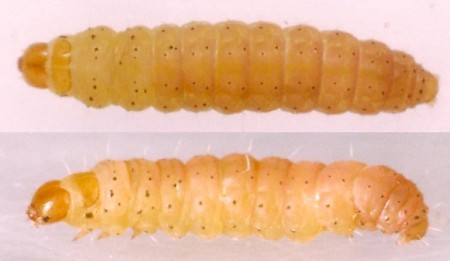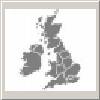
35.145 BF775
Neotelphusa sequax
(Haworth, 1828)
Wingspan 11-14 mm.
The distribution of this species follows that of its principal foodplant, common rock-rose (Helianthemum nummularium), which is confined to chalk and limestone in southern Britain, but extends onto base rich soils over basalt in N.E. England and well-drained mildly acid pasture and heaths in E. Scotland. The adult can be obtained by sweep-netting rock-rose in July.
The larva feeds in May and early June in a spun terminal shoot of common rock-rose (Helianthemum nummularium) or hoary rock-rose (Helianthemum oelandicum). The spinning is often a tight ball, rendered prominent by the exposure of the whitish undersides of the leaves. The appearance of the larva should be checked, especially when the spinning is less tidy, to avoid confusion with polyphages, such as Epiphyas postvittana which can be abundant on rock-rose.
Pupation is late June - early July among detritus on the ground.
- Larva: (description Ian F. Smith):
Foodplant: May to early June in a spun terminal shoot of Common rock-rose (Helianthemum nummularium) or Hoary rock-rose (Helianthemum oelandicum).
Intermediate instar
Length: 7 mm, early May.
Head: Brown ochre. Frons edged darker. Stemmatal area black.
Prothoracic shield: Brown with blackish lateral and posterior markings.
Thoracic legs: Light brown.
Body: Dull grey-green. Translucent showing gut. Venter paler.
Spiracles: Black.
Pinacula: Small, black.
Setae: Translucent. Base tinted with body colour.
Anal segment: Anal plate coloured as body, slightly paler.
Prolegs: Coloured as venter.Late instar
Length: 8 mm, late May.
Head: Burnt ochre. Posterior finely edged dark brown. Stemmatal area black.
Prothoracic shield: Shiny. Burnt ochre. Posteriorly and laterally finely edged dark brown. Divided by fine pale medial line.
Thoracic legs: Greenish brown.
Body: Yellowish olive. Dorsum slightly darker.
Spiracles: Black.
Pinacula: Small, black.
Setae: Translucent. Base tinted with body colour.
Anal segment: Anal plate coloured as body.
Prolegs: Coloured as venter.Final instar
Length: (Length not recorded). Early June.
Head: Gold ochre. Posterior finely edged dark brown. Stemmatal area black.
Prothoracic shield: Brownish yellow, paler than head. Posteriorly and laterally finely edged dark brown. Divided by fine pale medial line.
Thoracic legs: Pale ochre.
Body: Yellow. Dorsum of abdomen dull pinkish orange.
Spiracles: Black.
Pinacula: Small, black.
Setae: Translucent whitish.
Anal segment: Anal plate brownish yellow. No markings.
Prolegs: Coloured as venter.

 UKMoths
UKMoths 






